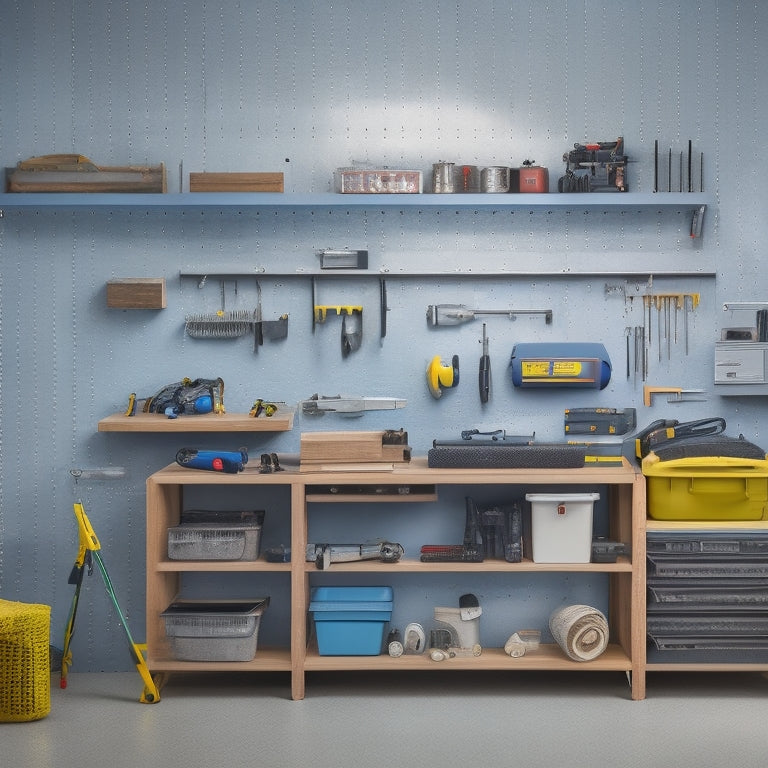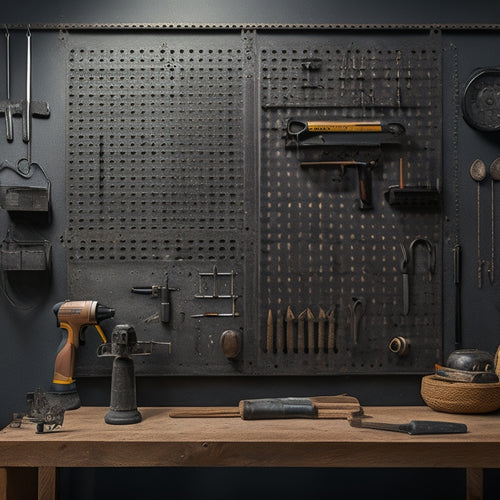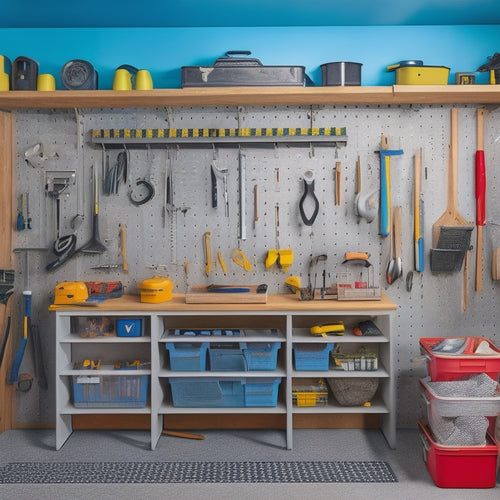
Design Your Ideal Tool Storage Layout for Free
Share
You can design your ideal tool storage layout for free using online tools and a few simple planning steps. Start by choosing a design tool that fits your level of experience, from beginner-friendly online options to popular software like SketchUp and AutoCAD. Measure your storage space, considering obstructions and overhead space. Then, design for efficiency by mapping your workflow and storing tools vertically. Customize your layout to fit your needs, prioritizing frequently used tools and creating a functional, durable, and safe space. Now, take the first step towards maximizing your productivity and transforming your tool storage experience.
Key Takeaways
• Utilize free design software like Floorplanner, SketchUp Free, or Planner 5D to create a customized tool storage layout.
• Measure your storage space accurately, considering obstructions and optimizing available space for maximum efficiency.
• Design your layout around frequently used tools, storing them vertically and utilizing overhead storage for easy access.
• Group similar tools together and arrange them based on your personal workflow to enhance efficiency and functionality.
• Customize your layout to fit your specific needs and preferences, prioritizing durability, quality, and safety measures.
Choosing the Right Design Tool
To effectively plan your ideal tool storage layout, you need to select a design tool that fits your needs and skill level. You'll want a tool that's easy to use, even if you're not a seasoned designer.
When it comes to choosing between SketchUp vs AutoCAD, consider your level of experience and the complexity of your design. SketchUp is a more user-friendly option, perfect for beginners or those who want to create a simple layout. AutoCAD, on the other hand, is a more advanced tool that offers precision and intricate design capabilities.
If you're new to design, online design tools can be a great starting point. They're often free or low-cost, and many offer tutorials or guides to help you get started. Look for tools that offer a drag-and-drop interface or pre-made templates to make the design process smoother.
Top Free Design Software Options
You'll find a range of free design software options that can help you create your ideal tool storage layout without breaking the bank. These online platforms offer interactive tools that make it easy to visualize your space and design a layout that works for you.
One popular option is Floorplanner, which provides a user-friendly interface and a vast library of objects to help you create a 2D or 3D design. Another great choice is SketchUp Free, which offers a web-based platform and a vast collection of templates and models to get you started. You can also consider Planner 5D, which provides a simple and intuitive interface for creating 2D and 3D designs.
All of these options are free, easy to use, and require no prior design experience. With these tools, you can experiment with different layouts, test out different ideas, and create a design that meets your specific needs and preferences. By leveraging these free design software options, you can create a tool storage layout that's both functional and efficient.
Measuring Your Tool Storage Space
As you start designing your ideal tool storage layout, accurately measuring your space is crucial.
You'll need to record the dimensions of the area, including any obstructions, to guarantee a perfect fit for your tools and storage solutions.
Space Dimensions Matter
Space Dimensions Matter
Measure your tool storage space carefully, since every inch counts when it comes to maximizing storage capacity and efficiency. You'll want to optimize organization and make the most of your available space. Take precise measurements of the length, width, and height of your storage area, as well as any obstructions like pipes, electrical outlets, or windows.
| Measurement | Description |
|---|---|
| Length | Measure from one wall to the opposite wall |
| Width | Measure from one side wall to the opposite side wall |
| Height | Measure from the floor to the ceiling |
When taking measurements, consider the size and shape of your tools and equipment. Will you need to store large, bulky items or smaller, more compact ones? Think about the functional layout you want to achieve and how you can create a practical design that meets your needs. By accurately measuring your space, you'll be able to create a tailored storage plan that maximizes space and boosts efficiency.
Wall Clearance Needed
With your space dimensions in hand, now it's time to contemplate the wall clearance needed to accommodate your tools and equipment. You'll want to make sure there's enough room for easy access and retrieval of your tools, while also considering the clearance requirements for each item.
Start by identifying the largest or bulkiest items, such as table saws or drill presses, and plan your layout around them. Consider the swing radius of doors and drawers, as well as any overhead obstructions like pipes or ductwork.
When determining wall clearance, think about the organizing strategies that will work best for you. Will you use pegboards, hooks, or bins? How much space will you need for frequently used tools versus less frequently used ones?
Effective layout optimization and space utilization rely on careful planning and consideration of these factors. By taking the time to evaluate your needs and plan accordingly, you'll be able to create a tool storage layout that maximizes your space and streamlines your workflow.
Corner Utilization Ideas
You'll want to capitalize on the often-wasted real estate in your tool storage space by incorporating corner utilization ideas that maximize every inch of available room. This area is often neglected, but with the right strategies, you can turn it into a valuable storage spot.
Here are some ideas to get you started:
-
Use corner shelving to store smaller items like bins, baskets, or tools. This will keep them organized and easily accessible.
-
Install hanging hooks to hang items like cords, hoses, or accessories. This will keep them off the floor and prevent tangles.
-
Consider a carousel or rotating shelf to make the most of the corner space. This will allow you to store more items in a smaller area and easily access what you need.
Designing for Maximum Efficiency
Designing for Maximum Efficiency
Start by mapping out your workflow to identify the tools you use most frequently and the sequences in which you use them. This will help you determine the most efficient layout for your tool storage.
Think about the tasks you perform regularly and the tools required for each task. Identify the tools you use together and those that can be stored in close proximity.
Next, consider storage optimization strategies to maximize your space. Look for opportunities to store tools vertically, utilize overhead storage, or incorporate multi-tiered shelving.
This will help reduce clutter and free up floor space, making it easier to move around and access your tools.
Customizing Your Tool Storage Layout
Now that you've optimized your storage space, it's time to customize your tool storage layout to fit your specific needs and preferences. This is where you get to tailor your layout to suit your workflow, making it easier to find what you need when you need it.
To achieve this, consider the following key aspects of tool organization:
-
Frequency of use: Place your most frequently used tools in easy-to-reach locations, reducing the time spent searching for them.
-
Tool categories: Group similar tools together, such as all your drilling tools or measuring instruments, to create a logical and intuitive layout.
-
Personal workflow: Think about your personal workflow and the sequence of tasks you typically perform. Arrange your tools in a way that mirrors this workflow, making it easier to shift between tasks.
Bringing Your Design to Life
With your customized tool storage layout planned, it's time to start building and arranging your storage solutions to bring your design to life. You've got a solid blueprint, now it's time to make it a reality.
Consider your budget considerations and material options carefully. Will you opt for durable steel shelves or versatile modular cabinets? Think about the color scheme that will best match your workspace aesthetic. Will a bold, bright color scheme energize your space, or a more subdued tone create a calming atmosphere?
As you start building, don't forget to prioritize ergonomic features. You want your tool storage to be functional and comfortable to use. Consider the height and accessibility of your storage solutions to guarantee you're not straining your back or wasting precious time searching for tools.
With a little creativity and resourcefulness, you can turn your design into a functional, efficient, and visually appealing tool storage system that makes your work easier and more enjoyable. By bringing your design to life, you'll be able to focus on what matters most – serving others with excellence.
Frequently Asked Questions
Can I Design a Tool Storage Layout for a Small Garage or Shed?
You can definitely create a tool storage layout for a small garage or shed by focusing on space optimization and organization solutions that prioritize efficiency and accessibility features, ensuring you can easily find what you need.
How Do I Ensure My Design Is Compatible With My Existing Tools?
When planning your tool storage layout, you'll want to verify compatibility with your existing tools by taking inventory, measuring their dimensions, and incorporating them into your design through a thorough tool organization and compatibility check.
Are There Any Specific Design Considerations for Heavy or Oversized Tools?
You're thinking heavy-duty storage, but don't want a layout that's as clunky as the tools themselves. Consider weight distribution and organization for efficient storage, ensuring accessibility and ease of use - it's all about balance.
Can I Customize My Design for a Specific Type of Tool or Trade?
You can customize your design to fit specific tools or trades by incorporating custom toolboxes and trade-specific storage solutions, ensuring your most-used items are easily accessible and organized for maximum efficiency.
How Often Should I Reassess and Update My Tool Storage Layout?
You're probably used to tackling projects head-on, but your tool storage layout needs regular evaluations to stay efficient. Consider reassessing every 6-12 months to identify necessary updates, ensuring your workflow stays smooth and your tools remain organized.
Related Posts
-

Heavy-Duty Pegboard Hooks for Industrial Use
You need heavy-duty pegboard hooks that can withstand the rigors of industrial use, providing a reliable and efficien...
-

Advantages of a Pegboard System in Your Garage
You can instantly alter your garage into a more organized, efficient, and productive space by installing a pegboard s...
-

What Are the Advantages of a Wooden Tool Box
You choose a wooden tool box, you're not only getting a reliable storage solution, but also a long list of benefits t...


